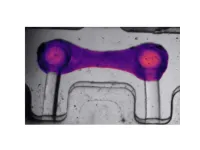(Press-News.org) Embargoed for release until 5:00 p.m. ET on Monday 8 April 2024
Annals of Internal Medicine Tip Sheet
@Annalsofim
Below please find summaries of new articles that will be published in the next issue of Annals of Internal Medicine. The summaries are not intended to substitute for the full articles as a source of information. This information is under strict embargo and by taking it into possession, media representatives are committing to the terms of the embargo not only on their own behalf, but also on behalf of the organization they represent.
----------------------------
1. Data shows medical marijuana use decreased in states where recreational use became legal
Abstract: https://www.acpjournals.org/doi/10.7326/M23-2811
URL goes live when the embargo lifts
The most up-to-date data on registered medical cannabis use found that enrollment in medical cannabis programs increased overall between 2016 and 2022, but enrollment in states where nonmedical use of cannabis became legal saw a decrease in enrollment. Combined with the data from a previously published analysis, the number of patients using cannabis for medical purposes has increased more than 600 percent since 2016. The study is published in Annals of Internal Medicine.
Cannabis is legal for medical or nonmedical adult use in 38 and 23 states, respectively. However, it remains a schedule I substance under the Controlled Substances Act. This status has inhibited research on its health effects and disincentivized many physicians from pursuing education related to or treating patients who use cannabis. Recently, the Department of Health and Human Services recommended that cannabis be rescheduled to schedule III. Before this potential shift occurs, it is important to understand the current landscape of medical and nonmedical cannabis use and authorization.
Researchers from University of Michigan Medical School and the Centers for Disease Control and Prevention conducted an ecological study with repeated measures of persons with medical cannabis licenses and clinicians authorizing cannabis licenses in the United States between 2020 and 2022. The authors included 39 jurisdictions (38 states and Washington, D.C.) that allowed for medical cannabis use in their analysis. Of these jurisdictions, 34 reported patient numbers, 19 reported patient-reported qualifying conditions, and 29 reported authorizing clinician numbers. Overall, they reported a 33 percent increase in patient enrollment in these jurisdictions between 2020 (3.1 million) and 2022 (4.1 million). However, within the 15 jurisdictions with active adult use laws, 13 had decreasing enrollment. From 2020-2022, the proportion of patient-reported qualifying conditions with substantial or conclusive evidence of therapeutic value decreased from 70.4 to 53.8 percent. The most reported qualifying condition was chronic pain, followed by anxiety and post-traumatic stress disorder. The authors report that there were 29,500 clinicians who authorized medical cannabis in 2022, and the most common specialty of these clinicians was internal or family medicine. According to the authors, their findings highlight the need for better surveillance methods to adequately understand outcomes of medical cannabis use and thoughtful strategies and public health efforts to reduce harms from increased cannabis availability.
Media contacts: For an embargoed PDF, please contact Angela Collom at acollom@acponline.org. To speak with the corresponding author, Kevin F. Boehnke, PhD, please email kboehnke@med.umich.edu.
----------------------------
2. Salt substitution associated with lower risk for all-cause, cardiovascular mortality
Abstract: https://www.acpjournals.org/doi/10.7326/M23-2626
Editorial: https://www.acpjournals.org/doi/10.7326/M24-0860
URL goes live when the embargo lifts
A systematic review of 16 randomized controlled trials found that the use of a salt substitute in food preparation was associated with a lower risk for both all-cause and cardiovascular mortality. The analysis is published in Annals of Internal Medicine.
Cardiovascular disease is the leading cause of death globally, and its onset is associated with high dietary sodium intake. Despite calls from organizations like the World Health Organization for people worldwide to reduce sodium intake, global sodium consumption still exceeds the recommended daily limit. Substituting table salt with a substitute containing reduced sodium and increased potassium may be a minimally invasive, achievable strategy to reduce sodium intake.
Researchers from Bond University, Queensland, Australia, conducted a systematic review and meta-analysis of 16 randomized controlled trials (RCTs) of persons using regular table salt or salt substitutions for at least six months. They found that salt substitution may reduce all-cause or cardiovascular mortality, but the evidence for reducing cardiovascular events and for not increasing serious adverse events is uncertain. The authors found that 8 of the 16 included RCTs studied primary outcomes. Of these, 7 studies occurred in China or Taiwan. Additionally, 7 of the 16 studies included older persons, who are at higher risk for cardiovascular disease. Because of these factors, generalizability to a population with an average cardiovascular disease risk or eating a Western diet is limited.
An accompanying editorial by authors from the University of Sydney, University of California San Diego, and University of New South Wales highlights the lack of changes made by governments and the global food production history to tackle the World Health Organization’s recommendations to reduce worldwide sodium consumption by 30 percent by 2025. The authors suggest that the widespread use of salt substitutions provide an achievable, accessible means to reaching that goal for the global food production industry.
Media contacts: For an embargoed PDF, please contact Angela Collom at acollom@acponline.org. To speak with the corresponding author, Loai Albarqouni, MD, MSc, PhD, please contact lalbarqo@bond.edu.au.
----------------------------
3. Resistance training no better than neuromuscular exercise in persons with hip osteoarthritis
Abstract: https://www.acpjournals.org/doi/10.7326/M23-3225
URL goes live when the embargo lifts
A study of persons with hip osteoarthritis (OA) found no difference between progressive resistance training (PRT) and neuromuscular exercise (NEMEX) for improving functional performance, hip pain, or hip-related quality of life. The study is published in Annals of Internal Medicine.
High-quality evidence has shown that exercise is effective in reducing pain and improving physical function in hip OA, and clinical guidelines recommend exercise as first-line treatment. NEMEX and PRT are both exercise programs meant to improve pain, physical function, and quality of life in persons with hip OA. However, there is limited evidence comparing any exercise programs or establishing optimal exercise content or dosage in persons with hip OA.
Researchers from Aarhus University Hospital, Aarhus, Denmark, conducted a multicenter cluster randomized controlled trial of 160 persons with hip OA. Eighty-two participants were randomly assigned to PRT and 78 were assigned to NEMEX for 12 weeks. The PRT intervention consisted of 5 high-intensity resistance training exercises targeting muscles at the hip and knee joints. The NEMEX intervention included 10 exercises and emphasized sensorimotor control and functional stability. The authors found that there were no clinically relevant differences in outcomes between groups. However, the authors noted a slightly larger improvement in muscle strength and power for participants undergoing PRT and suggest that PRT may be a better option for patients who present with muscle weakness or are at risk for developing sarcopenia.
Media contacts: For an embargoed PDF, please contact Angela Collom at acollom@acponline.org. To speak with the corresponding author, Troels Kjeldsen, MSc, please contact tkjeldsen@clin.au.dk.
----------------------------
4. Physicians debate best management strategy for patient at risk for HIV exposure
‘Beyond the Guidelines’ features are based on the Department of Medicine Grand Rounds at Beth Israel Deaconess Medical Center
Abstract: https://www.acpjournals.org/doi/10.7326/M24-0217
URL goes live when the embargo lifts
In a new Annals ‘Beyond the Guidelines’ feature, two physicians experienced in HIV antiretroviral pre-exposure prophylaxis (PrEP) debate how best to identify those patients who might benefit from PrEP, how to decide what regimen to use, and how to monitor therapy. All ‘Beyond the Guidelines’ features are based on the Department of Medicine Grand Rounds at Beth Israel Deaconess Medical Center (BIDMC) in Boston and include print, video, and educational components published in Annals of Internal Medicine.
Despite advances in treatment, HIV infection remains an important cause of morbidity and mortality, and more than 30,000 new cases are diagnosed in the United States each year. Several interventions have traditionally been used to prevent HIV transmission, but these vary in effectiveness, and there are challenges in their implementation. Both the CDC and the USPSTF strongly recommend the use of HIV PrEP for persons at risk. However, the implementation of PrEP in clinical practice has been variable, especially among patients underserved by the medical system and marginalized by society. Fewer than one-third of persons in the United States who are eligible for PrEP currently receive it.
BIDMC Grand Rounds discussants, Douglas Krakower, MD, Associate Professor of Medicine at Harvard Medical School and a member of the Division of Infectious Diseases at Beth Israel Deaconess Medical Center and Jessica L. Taylor, MD, Assistant Professor of Medicine at Boston University School of Medicine and Medical Director of Faster Paths to Treatment at Boston Medical Center, recently debated the case of Ms. S, a 30 year-old woman with substance use disorder who is at risk for HIV infection and has intermittently received PrEP.
In his assessment, Dr. Krakower recommends that Ms. S receive PrEP given her high risk for HIV infection. He also recommends injectable cabotegravir because of psychosocial challenges interfering with persistent daily pill use. Dr. Taylor recommends that Ms. S should be offered PrEP where she already accesses addiction treatment, harm reduction, and other services. She recommends that Ms. S receive daily oral TDF/FTC, as it is the only medication with evidence for HIV prevention among both people who inject drugs and people at risk via vaginal sex. Dr. Krakower believes that robust support from an interprofessional health care team would be essential to maintain adherence to any PrEP method. In addition, he would recommend counseling on safer sexual and injection behaviors, as well as treatment of HCV infection after resolution of her acute medical issues. Dr. Taylor suggests that in the future, a switch to cabotegravir could be considered, acknowledging the gaps in evidence for parenteral exposure. She also recommends other HIV prevention interventions, including continued methadone treatment, provision of condoms and sterile injection equipment, and the availability of STI testing and treatment, should be optimized.
A complete list of ‘Beyond the Guidelines’ topics is available at www.annals.org/grandrounds.
Media contacts: For an embargoed PDF, please contact Angela Collom at acollom@acponline.org. For an interview with the discussants, please contact Kendra McKinnon at kmckinn1@bidmc.harvard.edu.
END
Data shows medical marijuana use decreased in states where recreational use became legal
2024-04-08
ELSE PRESS RELEASES FROM THIS DATE:
Houston-area energy startup incubator wins phase 1 of DOE competition
2024-04-08
The U.S. Department of Energy’s Office of Technology Transitions (OTT) selected Texas Innovates, a non-profit organization focused on hydrogen and carbon innovation and expansion in the greater Houston and Gulf Coast region, as one of 23 phase 1 winners of the Energy Program for Innovation Clusters (EPIC) Round 3 competition. Notably, Texas Innovates is the only Texas entity to advance to phase 2 of the competition.
“We have been working towards this day since we identified the need for energy hardware incubation in 2017 and were a finalist in 2019 for C40 Cities global competition to make Houston’s Velasco Incinerator ...
A pulse of innovation: AI at the service of heart research
2024-04-08
A Pulse of Innovation: AI at the Service of Heart Research
Columbia biomedical engineers use AI to build a transformative new tool to study and diagnose heart function
Understanding heart function and disease, as well as testing new drugs for heart conditions, has long been a complex and time-consuming task. A promising way to study disease and test new drugs is to use cellular and engineered tissue models in a dish, but existing methods to study heart cell contraction and calcium handling require a good deal of manual work, are prone to errors, and need expensive specialized equipment. There clearly is a critical medical ...
Targeting vulnerability in B-cell development leads to novel drug combination for leukemia
2024-04-08
Despite having an overall survival rate of 94%, B-cell acute lymphoblastic leukemia (B-ALL), the most common childhood cancer, can prove challenging to treat, with survival among relapsed or resistant cases falling between 30-50%. Recent work by St. Jude Children’s Research Hospital scientists discovered which tumor cells resist treatment and why. This enabled the rational design of a combination therapy that better controlled high-risk subtypes of B-ALL in mouse models. The findings were published today in Cancer Cell.
“We found a new explanation of B-ALL ...
People make more patient decisions when shown the benefits first
2024-04-08
Key takeways
UCLA psychologists asked experiment participants to choose to receive $40 in seven days or $60 in 30 days, for example, under a variety of time constraints.
The experiment showed that people tend to make more impulsive decisions if they think about time delays first, and more patient decisions if they think about the greater reward associated with waiting longer.
The findings could be applied where people are being encouraged to make life choices that will benefit them in the long run, such as eating healthier, exercising or saving for retirement, by emphasizing the future large rewards and deemphasizing ...
New diagnostic tool achieves accuracy of PCR tests with faster and simpler nanopore system
2024-04-08
EMBARGOED UNTIL APRIL 8, 2024 AT 3:00 PM U.S. ET/ 12:00 PM PT
Over the past four years, many of us have become accustomed to a swab up the nose to test for COVID-19, using at-home rapid antigen tests or the more accurate clinic-provided PCR tests with a longer processing time. Now a new diagnostic tool developed by UC Santa Cruz Distinguished Professor of Electrical and Computer Engineering Holger Schmidt and his collaborators can test for SARS-CoV-2 and Zika virus with the same or better accuracy as high-precision PCR tests in a matter of hours.
In a new paper in the journal Proceedings of the National Academy of Sciences, Schmidt ...
Pregnancy accelerates biological aging in a healthy, young adult population
2024-04-08
Pregnancy may carry a cost, reports a new study from the Columbia University Mailman School of Public Health. The research, carried out among 1735 young people in the Philippines, shows that women who reported having been pregnant looked biologically older than women who had never been pregnant, and women who had been pregnant more often looked biologically older than those who reported fewer pregnancies. Notably, the number of pregnancies fathered was not associated with biological aging among same-aged cohort ...
Different means to the same end: How a worm protects its chromosomes
2024-04-08
University of Michigan researchers have discovered that a worm commonly used in the study of biology uses a set of proteins unlike those seen in other studied organisms to protect the ends of its DNA.
In mammals, shelterin is a complex of proteins that "shelters" the ends of our chromosomes from unraveling or fusing together. Keeping chromosomes from fusing together is an important job: chromosomes carry our body's DNA. If chromosome ends fuse, or if they fuse with other chromosomes, ...
ADA Forsyth scientists discover new phage resistance mechanism in phage-bacterial arms race
2024-04-08
One of the most abundant and deadliest organisms on earth is a virus called a bacteriophage (phage). These predators have lethal precision against their targets – not humans, but bacteria. Different phages have evolved to target different bacteria and play a critical role in microbial ecology. Recently, ADA Forsyth scientists exploring the complex interactions of microbes in the oral microbiome discovered a third player influencing the phage-bacterial arms race – ultrasmall bacterial parasites, called Saccharibacteria or TM7.
In the study, which appeared in Proceedings of the National Academy of Sciences ...
Deep parts of Great Barrier Reef ‘insulated’ from global warming – for now
2024-04-08
Some deeper areas of the Great Barrier Reef are insulated from harmful heatwaves – but that protection will be lost if global warming continues, according to new research.
High surface temperatures have caused mass “bleaching” of the Great Barrier Reef in five of the last eight years, with the latest happening now.
Climate change projections for coral reefs are usually based on sea surface temperatures, but this overlooks the fact that deeper water does not necessarily experience the same warming as that at the surface.
The new study – ...
How climate change will impact food production and financial institutions
2024-04-08
Researchers at the University of California San Diego School of Global Policy and Strategy have developed a new method to predict the financial impacts climate change will have on agriculture, which can help support food security and financial stability for countries increasingly prone to climate catastrophes.
The study, published today in the Proceedings of the National Academy of Sciences, uses climate and agricultural data from Brazil. It finds that climate change has a cascading effect on farming, leading to increased loan defaults for ...




